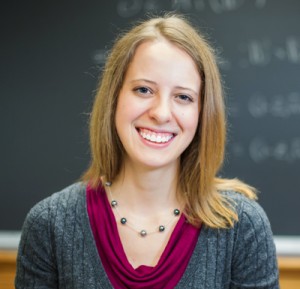Professor Nema Dean from the University of Glasgow will be visiting our department August 19 – September 1. On Tuesday August 22 she will give a faculty colloquium on “A general introduction to modelling areal spatial data” at 4:00 in Olin 372.
Category: Uncategorized
Distinguished Visiting Professor Talk: Il Bong Jung 2/28 @ 4 pm in Olin 372
Title: Quasinormality and weak quasinormality of operators
Abstract: There are two notions to define the quasinormality of unbounded operators by Kaufman and Stochel-Szafraniec respectively. Our results show that Kaufman’s definition of an unbounded quasinormal operator coincides with that given by Stochel-Szafraniec. In this talk we discuss various characterizations of unbounded quasinormal operators. Examples demonstrating the sharpness of our results are constructed. An absolute continuity approach to quasinormality which relates the operator in question to the spectral measure of its modulus is developed. This approach establishes a new definition to be called weakly quasinormal operators. Some characterizations concerning to the weakly quasinormal operators are discussed. In addition, various examples and counterexamples illustrating the concepts of this work are constructed by using weighted shifts on directed trees.
Distinguished Visiting Professor Talk: Ralf Schmidt 1/31 @ 4 pm in Olin 372
Abstract: In its original meaning, Number Theory is concerned with the properties of the “natural” numbers 1, 2, 3, … In this talk we will attempt to explain how the consequent study of “elementary” properties of numbers leads naturally to the theory of automorphic forms and the vast web of conjectures known as the “Langlands program”.
DVP Talk: Amanda Folsom, 4/19 @ 4
Title: Mock and quantum modular forms
Abstract: Mock modular forms were first formally defined in the literature by Zagier in 2007, though their roots trace back to the mock theta functions, curious power series described by Ramanujan in his last letter to Hardy in 1920. As the overarching theory of harmonic Maass forms has progressed over the last 15 years, we have seen applications of mock modular forms in number theory, combinatorics, representation theory, and more. Zagier also defined quantum modular forms in 2010, which like mock modular forms feign modularity in some way, but unlike mock modular forms are only defined on sets of rational numbers. In this talk, we will give an introduction to and brief history of these subjects. We will also discuss an application in joint work with Ken Ono (Emory) and Rob Rhoades (CCR Princeton), in which we revisit Ramanujan’s last letter and prove one of his remaining claims as a special case of a more general result.
Student Talk Series: Matt Mizuhara ’12, March 24th @ 12 noon in Olin 268
Title: Mathematical biology under the microscope: A study of cell motility
Abstract: Although physics and chemistry have long relied on mathematics as a descriptive and exploratory tool, biological systems were historically seen as too complex to be understood theoretically. However, advances in mathematics and computational capabilities now allow for the quantification of biological problems in a field called mathematical biology.
In this talk I will introduce a modern topic of mathematical biology: crawling cell motility. Cell motion plays a central role in wound healing and the immune response, e.g., to fight foreign bodies. We will present a partial differential equation model for cell motion proposed by Ziebert et al. (2011). The subsequent analytical and numerical studies give rise to surprising mathematical results as well as novel insights for biologists, including applications to directed cell motility and sorting. This talk will not require any prerequisite knowledge of partial differential equations or biology, though a calculus background will be helpful.
Student Talk Series: Mark Meyer, January 28th @ 12 noon in Olin 268
Title: I’m all about that Bayes, ’bout that Bayes.
Abstract: A September 2014 New York Times article titled “The Odds, Continually Updated” discusses the growing popularity of Bayesian statistics both within and outside of the statistical community. This expansion is due in part to the growth of computing power over the last decade and a half. So what is Bayesian statistics? The title of the article, and indeed the article itself, suggest that Bayesian statistics uses, even requires, prior information to inform the analysis. But this is only a small aspect of the Bayesian approach. We can use Bayesian statistics to analyze any data and, as we shall see, it can even provide more informative solutions than the Frequentist, or classical, approach to many problems. This talk will discuss the two philosophies of statistics: Bayesian and Frequentist. In doing so, we will cover some history behind the Bayesian paradigm, introduce the general approach to Bayesian statistics, and discuss several real examples, in each case comparing the Bayesian and Frequentist approaches to each other.
DVP Talk: Sam Ventura, 12/7 @ 4 pm in Olin 264
Title: Classification and Clustering for Record Linkage in Large Datasets
Abstract: Record linkage, or the process of linking records corresponding to unique entities within and/or across data sources, is an increasingly important problem in today’s data-rich world. Due to issues like typographical errors, name variation, and repetition of common names, linking records of unique entities within and across large data sources can be a difficult task, in terms of both accuracy and computational feasibility. We frame record linkage as a clustering problem, where the objects to be clustered are the records in the data source(s), and the clusters are the unique entities to which the records correspond. We use the following three-step approach for record linkage: First, records are partitioned into blocks of loosely similar records to reduce the comparison space and ensure computational feasibility. We propose a sequential blocking approach that iterates through a nested set of decreasingly strict blocking criteria to reduce the comparison space more efficiently. Second, we adopt an ensemble supervised learning approach to estimate the probability that a pair of records matches. We propose a new adaptive prediction approach for classifier ensembles (specifically, random forests) that extracts and incorporates summary statistic information from the distribution of estimated probabilities. Third, after transforming our estimated pairwise probabilities of matching to pairwise dissimilarities, we use hierarchical clustering to link matching records. We apply these approaches to two labeled record linkage datasets: a set of labeled inventors from the United States Patent and Trademark Office database and a compilation of lists of death records from the Syrian Civil War conflict.
Student Talk Series: Kelly Bickel, Bucknell University, Thursday, September 3rd in Olin 268 @ noon
Title: Geometry, Meet Origami
Abstract: In this talk, we will go back in time to the ancient Greeks (or at least your high school geometry class) and take a good look at what we can draw with a compass and straight-edge. The answer is “Not Much!,” at least when compared to what a little paper folding will get us. Come prepared to trisect some angles, double some cubes, and scoff at the circle squarers.
The Bucknell Pre-calculus Requirement
College-level mathematics is exciting and empowering, and the Mathematics Department wants your experience to begin in the best way possible! We are providing and requiring a 6-week online preparation course—the ALEKS Prep. for Calculus—for all students who will take MATH 201. Results from previous years show that working through this online course will get you started on the path to success in college calculus.
The Prep. for Calculus course will be available starting July 19. The deadline for completion for Fall Calculus enrollment is Aug. 29; we recommend you start by Aug 1. Students with a Spring Calculus enrollment may choose to complete this requirement over the summer or over winter break.
To get started, read the Prep. for Calculus Information sheet then visit the Bucknell ALEKS Prep. for Calculus Moodle page.
Actuarial internships
Aetna: (https://www.aetna.com/about-us/student-programs.html)
General listing at the bottom of http://www79.homepage.villanova.edu/charles.ashley/actuary.htm
Towers Perrin: actuarial internships; information available through Bucknell’s CDC
U.S. Government: see http://www.usajobs.gov







